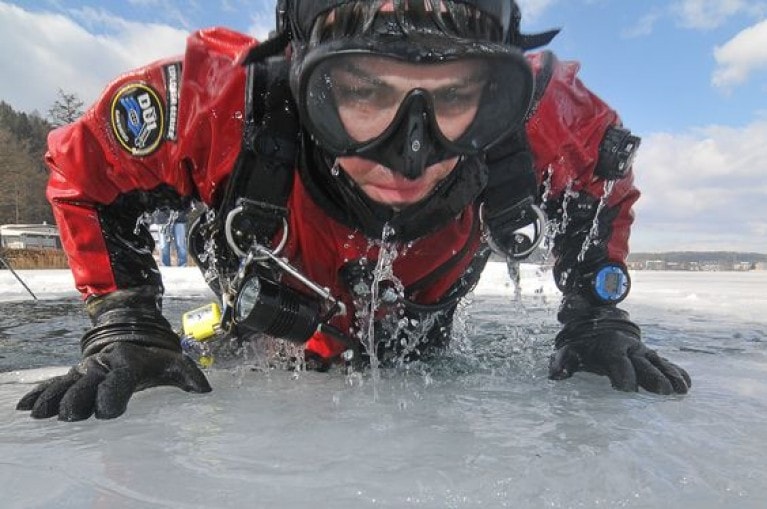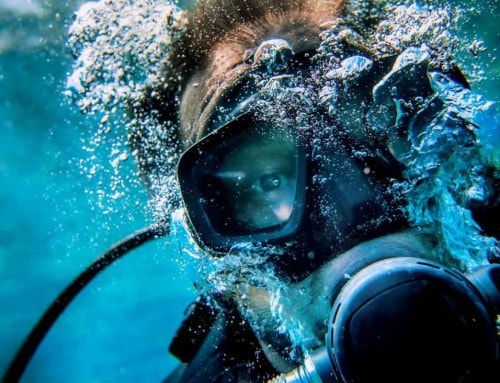Written by Kathy Long, Diver & DUI Web Systems Manager March 2015
Cotton is good for babies. Not so good under your drysuit
Did you know the majority of drysuits on the market today are NOT designed to keep you warm? It’s true. These amazing garments are only designed to keep you dry. That’s a big difference.
By far, the majority of drysuits on the market today are considered “shell” drysuits. Often, divers will purchase a drysuit and give little attention or thought to the undergarments they will be wearing underneath. Using the wrong undergarments will literally keep you out in the cold.
A quick educational moment: Remember all insulation is “trapped air”. Think of that nice big fluffy parka in your closest. It’s warm and toasty because of all the air it can trap, and that trapped air is what protects you from the cold.
What NOT to do:
DO NOT WEAR COTTON
Cotton is a big NO under a drysuit. As we discussed in our DOG Trick article, “I Swear I Didn’t Pee in My Drysuit: divers, like all people, perspire. From the moment you get into your drysuit to the moment you remove it, your body is a little moisture factory. Your drysuit is keeping all the moisture in a confined environment. If you are wearing comfy cotton, it will absorb all this moisture and lay next to your body creating a nice, big chilling effect. As it absorbs more and more water, it loses whatever insulation it had. So now, not only do you no longer have the warmth from the cotton, you also have the added cold. Think about this: would you sleep with a wet blanket?
You’re heading to the dive site. It’s cold and miserable outside. You grab a cold drink and chug it. You under dress for the surface conditions and get cold even before your dive. This is a bad idea because you will only get colder as you dive. Prior to your dive stay as warm as you can, grab a warm drink, and wear gloves if it’s cold. Your body will appreciate you.
Down compresses and also absorbs water. Not a good choice for drysuit divers.
DO NOT FALL FOR THE FLUFF
Remember that big, fluffy parka? Why not take it diving? It does a great job on the ski hill and its way colder than today’s diving temperatures. Ah sorry to be the “wet blanket” here. Not a good idea. As soon as you hit the water the pressure will flatten out that fluffy parka and all of that insulation disappears.
DO NOT WEAR OLD UNDERWEAR
That sounds ickier than it is. What we mean by that is that old undergarments are not as warm. That lint in the dryer tray isn’t from magic. That’s fiber from your clothes. Your DiveWear loses insulation over time through laundering, repeated compressions and just overall wear. Treat yourself to new undies.
Now that we told you what NOT to do, what SHOULD YOU DO?
WEAR UNDERGARMENTS DESIGNED FOR DIVING
Not all insulation is created equal.
Polartec PowerStretch® Pro “ Don’t get fooled by the name Polartec. There are about 500 different types out there. The PowerStretch Pro is only manufactured in the US and is very high density fleece, meaning it is excellent at trapping air. It also has unparalleled stretch so it can be very form fitting allowing you to wear the least amount of weight.
Thinsulate Type B which is used in our Xm450 and Xm250Â DiveWear undergarments are the ideal choice for many divers. Type B is the type used in footwear and it’s already compressed. Thinsulate is the warmest insulation available for its thickness and it is hydrophobic, it won’t absorb water. This feature makes it the choice for divers doing decompression diving, as if there is a catastrophic failure, i.e. you blow your waterproof zipper, the insulation will still retain about 70% of its original warmth.
Ben is wearing a Plus 5 Vest. A perfect addition to your insulation strategy.
LAYER FOR ADDED WARMTH
Adding a layer will give you additional warmth and allows you to adjust your insulation based on your diving needs. Is the water a little chilly for your main garment? Add a base layer. Our ECODiveWear does an amazing job, AND it’s made from recycled materials. Need a little more? Add a vest. A good rule of thumb is you can go up to 3 layers. Any more than that, and you should go to a heavier main garment.
Bottom line, it’s easy to get cold even when you wear a drysuit. But with a little attention to what you wear underneath, every dive can be like a tropical vacation. It’s your passion. Enjoy it to the fullest!




